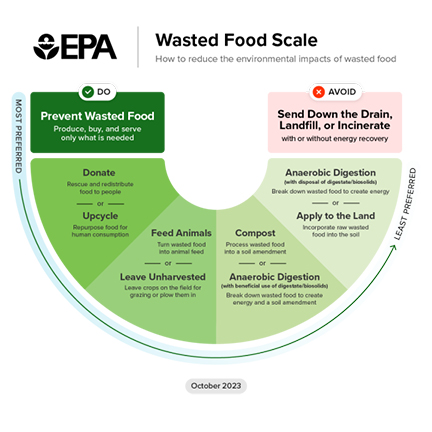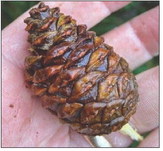Think hard before tossing out that unwanted food


The DNR’s 2020-21 Statewide Waste Characterization Study, found that wasted food and food scraps made up 20 percent of trash going to Wisconsin landfills. This amounts to approximately 854,000 tons annually, or 294 pounds, per person, in Wisconsin, during the study period.
The study estimated that more than three-quarters of this food could have been consumed by people. When food goes in the trash, so do resources, time and money.
Through the sustainable management of food, Wisconsinites can conserve resources, reduce greenhouse gas emissions, help businesses and consumers save money, and provide access to food for those who do not have enough to eat.
The goal is to reduce wasted food and its associated impacts over the entire life cycle, starting with using natural resources, manufacturing, sales and consumption, and ending with decisions on recovery or final disposal.
Preventing food from going to waste is the most environmentally beneficial option on the Wasted Food Scale. When food is wasted, all the resources that went into producing, processing, distributing and preparing the food are wasted, too. Plus, preventing food waste can save consumers money. A 2025 study from the Environmental Protection Agency (EPA) found that the cost of food waste to each U.S. consumer, is $728, per year.
Rescuing and donating wholesome surplus food is one of the most preferred pathways, because it ensures that food and the resources used to produce it, are not wasted. Most food donations come from higher up the food supply chain, such as from farmers, food manufacturers, distributors or retailers. But, schools, community organizations and individuals can also make a difference, by collecting and donating unspoiled, healthy food or participating in local food rescue efforts. By donating food, that helps people, not landfills, supporting local communities and saving all the resources that went into producing that food from going to waste.
The federal government provides tax deductions to incentivize businesses to donate food. In addition, donating food and grocery products can help companies reduce disposal costs.
State and federal laws protect food donors from liability. The federal 1996 Bill Emerson Good Samaritan Food Donation Act and the Food Donation Improvement Act of 2021, support donating food and groceries for distribution to those in need. The law protects donors from civil and criminal liability. If they donate a fit and wholesome product in good faith, they won’t be held responsible, if it later harms someone.
Wisconsin law, s. 895.51, Wis. Stats., also provides protection to any person engaged in the processing, distribution or sale of food products, for-profit or notfor- profit, who donates or sells qualified food, to a charitable organization or food distribution service. The person would be immune from civil liability for the death of or injury to any individual, caused by the qualified food donated or sold by the person.
Upcycled foods are made from ingredients that would otherwise have ended up in a food waste destination. Upcycling is common sense, because it makes the most of the food. Examples of upcycling include using misshapen or bruised fruit to produce jams, jellies or kombucha.
Food scraps and food processing waste may have the potential to be turned into animal feed. The food nourishes animals and diverts it away from landfills. Examples of this happening in Wisconsin, include the use of brewery and distillery spent grain for livestock feed. However, not all food waste is suitable for conversion to animal feed.
Using edible, human food products or food processing waste as animal feed, requires a Wisconsin Department of Agriculture, Trade and Consumer Protection (DATCP) commercial feed license.
When composting wasted food and scraps, and using the compost produced, returning the valuable nutrients and carbon contained in those materials back to the soil. Composting also extends landfill life, by diverting organic materials and protecting the climate, by reducing landfill methane emissions.
When organic matter, like food waste, decomposes during composting, it undergoes aerobic decomposition, meaning that it’s broken down by micro-organisms that require oxygen. That’s why compost needs to be turned occasionally, to get enough oxygen into the pile and keep the microorganisms alive. When organic matter goes to a landfill, it gets buried under other trash, cutting off a regular supply of oxygen. The waste then undergoes anaerobic decomposition, being broken down by organisms that can live without free-flowing oxygen. During anaerobic decomposition, these particular micro-organisms create methane gas as a by-product.
Although most modern landfills have methane capture systems, they do not capture all the gas. According to the EPA, landfills are the third-largest source of human- generated methane emissions in the United States. In 2020, the greenhouse gas emissions from landfilled food waste in the U.S., were equivalent to the annual emissions of 7 million homes’ energy use.
When composting is done correctly, methane emissions are negligible, compared to the significant amounts produced by landfills.
Anaerobic digestion is a process where micro-organisms break down organic (carbon-based) materials, such as waste food, in the absence of oxygen. The anaerobic digester may be a stand-alone digester that primarily processes wasted food, an on-farm digester that co-digests food waste with manures or a digester at a water resource recovery facility, that codigests food waste with wastewater solids.
Anaerobic digestion generates biogas, which can be a source of renewable energy. It also produces digestate or biosolids, nutrient-rich products that can be used beneficially, for example as fertilizer, soil amendment or animal bedding. When the digester is located at a water resource recovery facility, the final product is called biosolids.
Digestate and biosolids can be treated in a variety of ways, prior to being applied to land, for example, by composting. The use of digestate and biosolids on soils can offset the need for synthetic fertilizers, and enhance soil health.
Wasted food, and by-products from the food manufacturing and processing sector may be eligible for field application. The benefits and impacts of land application of food processing waste streams can vary widely, based on the composition of the wasted food.





